Redefining Animal Welfare
It is at this point that the conceptualization of animal welfare shifts from a purely instrumentalist notion, here welfare is equated for all intents and purposes with productive efficiency, to a re animalized notion based upon the physical health needs of the individual (including hunger, acute metabolic disease, discomfort, chronic pain, and exhaustion), its mental well being, and its natural behavior. […]
The Difficulty of Animal Welfare
The notion of farm animal welfare is directly linked, first, to the status of farm animals as chattels and commodities, belonging to and traded by farmers and others as a source of revenue and, second, to the fact that their lives, from birth and before, to death, are almost entirely controlled, adapted, and modified by human actors for the purposes of […]
Animal Welfare, Agricultural
Though arguably not a traditional area of geographical concern, agricultural animal welfare is currently attracting the interest of a growing number of human geographers. The (humanist) social sciences in general have long ignored farm animals, and, one might even claim, all animals, rendering them largely invisible and their agency unaccounted for in the analysis of human society. Yet, geography's relatively recent […]
More-than-Human, or Hybrid, Animal Geographies
Other animal geographies have, in recent years, sought to problematize the use of orthodox social categories in their theoretical and empirical approaches to the spatialities of human – nonhuman relations, encounters, and co productions of spaces. This includes ditching many aspects of political economy approaches whilst holding on to a focus on the wider networks in which animals are engaged and […]
Political-Economic Animal Geographies
Animal geographies that have utilized political economic analyses have mainly been found in rural and agricultural geographies. Such studies have at times focused on the development of certain intensive food production regimes as emblematic of current structures of capitalism. For example, studies have focused on chicken and hog intensive production systems in the USA, amongst other matters. Here, animals were always […]
Sociocultural Animal Geographies: Identities and Place
Much of the focus of sociocultural animal geographies has been on animal roles in construction and ordering of culture and individual human subjects, and wider links between human and animal identities in particular times and places. Some animal geographies have experimentally approached animals as something akin to a marginal social group that emphasizes unequal power relations between animals and people, and […]
New Animal Geographies
Many of the renewed animal geographies that emerged in the mid 1990s sought to put some distance between themselves and cultural ecology and Sauer's cultural geography, though some writers do point to a few continuities with that tradition. Such work emerged out of the new cultural geographies that took more materialist approaches to cultural interactions, post structuralist theories that decentered human […]
Early Cultural Geographies of Animals
In contrast to zoogeographical work, early twentieth century geographies of animals sought to examine how some animal distributions were affected by human groups through animal domestication and introductions of animals into new regions. Studies of animal domestication were rejuvenated by evolutionary theory in the late nineteenth and twentieth centuries – viewing animal domestication as one of the main qualities and practices that […]
Zoogeographies
What became known as zoogeography emerged at a time of unheralded exploration, colonial conquest and Empires, collections of animal and plant specimens to be returned to nations such as Britain and France, trophyhunting as an elite leisure pursuit, alongside, and inimical to, the development of scientific disciplines such as biology, geography, and zoology. As such zoogeography, or regional biogeography, should […]
Histories of Animal Geographies
Animals have long had a presence in geography as a discipline. In the modern period, two closely related approaches characterized a distinct study of animals in geography. The first became known as zoogeography and sought to map evolutionary distributions of animals and was closely allied to what was to become a more physical geographical approach, allied with zoology and the (then) emerging […]
Animal Geographies
Animal geographies might, at first, be thought a misnomer by those coming across the term for the first time. Current geographies of animals are not just about animals; how could they be? Instead, current animal geographies seek to challenge entrenched assumptions about animals in modern societies and in the historical developments of humanities disciplines. Recent animal geographies have […]
What about the Excluded? Critical Stances on the Anglo-American Hegemony Thesis
Critics of the 'Anglo-American hegemony' literature in human geography have built on a theoretical and political position that can be defined as 'post structuralist'. Post structuralist thinking, and notably its radical versions, finds its origins in a variety of intertwined strands of research and reflection, including feminism, postcolonial theory, and cultural studies, which have exerted growing influence during the […]
It Is Not Only a Matter of Publishing: The Issue of Access
The power geometries in academic publishing are not only dependent on 'immaterial' factors such as language, discourse, academic power, and cultural traditions, but also on 'material' access to scientific knowledge and, most notably, to academic journals. Thus, even if we would be able to challenge the Anglo-American hegemony with respect to language and the shaping of a more truly international discipline, we […]
Publication Practices and the Production of the ‘Other’
One obvious observation is that with English being the dominant language it is easier for native English speakers to publish in English language journals. But this is not simply because non native speakers have a language disadvantage and native speakers a language advantage, but also because the most important journals – or, in fact, almost all English language journals – are […]
Is There an Anglo-American Hegemony in Geography Journals? The Empirical Evidence
It is easier for native English speakers to publish in English language journals, just like it is easier for native French speakers to publish in French language journals, or for any other native speaker publishing in journals in her/his language for that matter. Yet, the situation is different because English is the dominant language in social science and so being a […]
Anglo-American/Anglophone Hegemony
One of the two authors of this article was born and raised in Italy, and is presently also working in an Italian university. The other was born and raised in the Netherlands, and has temporarily moved to an American university after having worked in a Dutch university for a number of years. Both of us grew up with […]
Charting a Course: The Potential Bricolage of Anarchism and Geography
The revolution in geography that Kropotkin and Reclus initiated well over a century ago remains tied to an as yet unfulfilled social revolution based upon anarchist principles and practices. Their prescient insights have nevertheless altered the practices of contemporary geographers and planning professionals in profound ways, and their ideas continue to present a challenge to all of the spatial disciplines and […]
Anarchist Epistemologies of Freedom: Challenging and Reconstructing Geographic Knowledge and Planning Practice
Neither Kropotkin nor Reclus abandoned their geography to become political and social anarchists. Instead, they set out to extend the idea of revolution and social critique from the realm of politics alone into the realm of geographic inquiry. Many contemporary geographers and planners have since taken on this project and applied anarchist social and spatial principles to both a critique […]
Anarchist Geographies: The Spatial Foundation of Anarchist Theory and Practice
Space is important to the social anarchist revolutionary project in several key respects. Social injustice, oppression, inequality, and the sources of power that underlie these relationships are often reflected in, or reveal themselves through, the structuring and appearance of the landscape and built environment. Anarchists also recognize the importance of creating social and physical spaces in which to develop strategies […]
The Historical Relationship of Anarchism and Geography
The confluence of anarchism as a political philosophy and geography as an emerging discipline occurred in the latter half of the nineteenth-century largely in response to European nation building and growing social inequities. As taught in the halls of European military colleges, geography was often complicit in promoting imperial conquest by mapping resources to benefit European nations. Two prominent dissidents within […]
Anarchism/Anarchist Geography
What Is Anarchism? Anarchism is a philosophy that argues against statism and a political order based on authority or hierarchy. It opposes the use of power to secure the privileges of a few, restrict individual freedom and deny the rich diversity of social life. While anarchism shares with socialism a critique of capitalism and the desire to replace […]
Future Directions
The twenty first century will bring greater cultural and economic integration to the Americas and increasing homogeneity in terms of the region's human geography. Throughout the twentieth century, the United States has been the region's hegemonic power, exerting a tremendous influence over both culture and economy. This dominance is unlikely to be seriously challenged in the coming century, although China's growing […]
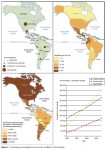
Contemporary Human Geography
The territory of the Americas is demarcated into some 22 sovereign nation states and one overseas territory, Guyane (French Guiana). The geographical size, population, economic clout, and role in the world political system of these nation states, varies tremendously. The United States, as one of the world's most powerful nation states, is both the region's most populous nation, with close […]
Cultural Commonalities
Although the human geography of the Americas is sometimes described as diverse, in fact the peoples of this region share many common cultural characteristics. These include similar colonial histories, cultural orientation, religious traditions, political values and systems, and economic organization. With the exception of Aus tralia, the contemporary human geography of the Americas is one of the least varied in the […]
Human Antecedents
Prior to the arrival of Europeans and their colonization of the Americas at the beginning in the early sixteenth century, Amerindian peoples had occupied much of the Americas for at least 10 000 years. The level of social and economic development among these peoples varied tremendously. Pre agricultural societies dependent on hunting and gathering, early agricultural communities, and highly developed advanced […]

Regional Perspectives
Conceptually, the Americas can be subdivided into subregions using distinct criteria. From an environmental or geographical perspective, it is often divided into three macro divisions – the continental landmasses of North America and South America, and the small narrow landbridge, Central America, which joins the two continents. The human geography of the region is better understood and conceptualized differently. At […]
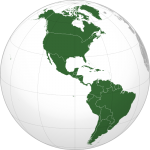
Americas
The Americas is an immense geographical region spanning two continents, North and South America, and includes the islands of the Caribbean Basin. While the Caribbean Basin is a part of the Americas, that subregion is covered elsewhere in this encyclopedia. The Americas lies fully within the Western Hemisphere. The region spans nearly 1501 of longitude extending from the eastern […]
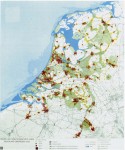
Few Examples of Territorial Development Policies
Netherlands It has already been said that Netherlands practiced territorial development before this expression was used. However, it has not been before 1962 that an act instituted territorial plans at the national scale. There has been, up to now, five such plans, plus revisions of some of them. This means that it is an evolutive planning, indicating priorities […]
The Five Great Dilemmas of Territorial Development
Territorial development is at the heart of many conflicts between objectives. Economic Development versus Territorial Equality The ordered disposition sought by territorial development does not necessarily correspond to an economic optimum, which would suppose a priority development of settlements and regions already favored by their localization, their assets in terms of manpower, image, etc. Territorial development, on the contrary, has, among […]
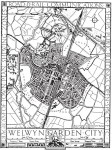
First Experiments
Netherlands: Struggle against the Sea Due to the exiguity of their territory (now 34 000 km2 for 16 million inhabitants) and to the permanent menace of maritime invasions (a large part of the territory is below sea level), Netherlands had a practice of territorial development of polders since the twelfth century, before the term existed. This country, which has been […]
Which Scientific Status for Territorial Development?
Amenagement du territoire (territorial development) cannot be considered as a science, which is a coherent ensemble of knowledge based on specific concepts and on theories and developing rules proved either by a rigorous demonstration or by experimentation. It can no more be qualified of being a technique, that is a savoir faire, a set of processes, of means, and […]
What Is Amenagement du Territoire or Territorial Development?
We suggest the following definition of Amenagement du territoire (territorial development): action and practice (rather than science, technique, or art) of disposing with order, through the space of a country and in a prospective vision, people and its activities, amenities, and means of communication they can use, taking in consideration natural, human, and economic (and even strategic) constraints in order that […]
Amenagement du Territoire: Territorial Development
It can be considered neither as a science nor as a technique, or as an art, but as a voluntary intervention or as the territorial aspect of planning. Therefore, it is a praxis (a set of actions aiming to the same objective) and a practice. It is fed less with theoretical rules or savoir faire than with empiricism. Therefore, […]
Aid
Different Types of Aid Reasons for Giving Aid Changing Trends in Development Aid Aid Conditionality Humanitarian Aid Critical Contemporary Aid Debates
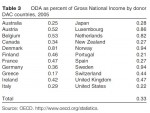
Critical Contemporary Aid Debates
Many critics have doubted the effectiveness of aid especially in the context of reducing poverty. Throughout the 1970s, the dependency theorists viewed aid as a source of exploitation and dominance by the northern countries. In the 1980s, ODA was challenged by the rise of the neoliberal agenda in the west as aid was now held to contribute to excessive government […]
Humanitarian Aid
Since the early 1990s, there has been both an increase in the number of disasters and a change in the nature of emergencies leading to a substantial increase in humanitarian assistance. Emergencies have changed in nature from mainly being natural disasters such as floods, famines, and droughts to complex emergencies such as the 'war on terror' post 11 September […]
Aid Conditionality
There was an increase in condition based lending in the 1980s based primarily on institutional reform and economic policies with strong neoliberal principles of market led development in developing countries. These economic conditions came to be known as the Washington Consensus. Recipient countries had to fulfill requirements such as structural adjustment programs (SAPS) which became a major feature […]
Changing Trends in Development Aid
In the early decades, development aid was given on an economic basis mainly to enhance productive capacity and bring about modernization of developing countries (influenced by modernization theories). Many developing countries in the initial phase of development, post decolonization, wanted to industrialize their econ omies. This led to imports of technologies (such as hybrid varieties of crops, fertilizers, imports of machinery, […]

Reasons for Giving Aid
The main objective of giving aid, since decolonization, is to eradicate poverty from developing countries. Although over the last 50 years other objectives have also emerged which influence donors. For example, around two thirds of Britain's aid has gone to Commonwealth countries to maintain close historical relationships. A has also been given to secure economic and political interests such as cheap labor, […]
Different Types of Aid
The main aim of aid (also known as 'official development assistance' – ODA) is to provide resources on concessional terms for the promotion of economic development and welfare in developing countries. Most often the transfer of these resources is in the form of grants and loans on concessional terms from the developed (mostly northern countries) to developing countries (mainly in the […]
Contested Models of Agri-Environmental Governance
At the same time, agri environmental concerns have been swept into an increasingly international debate about the broad nature of agricultural sustainability and the role of farmers in delivering this. The restructuring and relocation of production that is likely within an increasingly globalized agro food system may prove as damaging to habitats and landscapes as earlier periods of agricultural change and […]
Toward Greener Farm Policies?
The idea that farmers deserve special treatment because they are farmers was never likely to be defensible as a long term justification for state assistance. Policymakers have presented public good and social equity justifications for shielding farmers from world market forces for many decades, but it was not until the late 1980s that an environmental public good rationale was articulated with […]
Developing an Environmentalist Critique of Modern Agriculture
Environmentalist critiques of modern farming first emerged in places like Western Europe, the United States, and Canada during the late 1970s. Mounting evidence of the biodiversity, soil erosion, and off farm pollution impacts of agricultural intensification and specialization was brought to public attention by campaigning scientists and journalists and by conservation groups in both the EU and North America. In the […]
Agri-Environmentalism and Rural Change
The realization that modern, intensive agriculture could be environmentally damaging was slow to gain ground among policy elites in industrialized countries. Traditionally portrayed as environmental stewards engaged in the production of essential staples, farmers in most developed countries since the 1930s have received substantial levels of government support in order to achieve food security and public good policy goals. […]
Conclusions: Prospects and Challenges for Sustainable Agricultural and Rural Development
This article started by outlining some of the basic and time honored principles of sustainable agriculture. The proceeding synthesis, concerning the variant ways and vectors in which these principles have been (contestedly) grounded and conceptually developed by scholars, has demonstrated their continual and growing relevance. For much of the latter half of the twentieth century agricultural sustainability debates concentrated on both […]
Some Conceptual Building Blocks for the Sustainable Rural Development Paradigm
One common mistake about the new rural development paradigm (within the contemporary European context, at least) is to assume that it is simply a return to localism, and/or that it falls victim to the 'local trap' in general sustainability literatures. This assumes that there is an unproblematic set of elisions between the local embeddedness and overall sustainability. It is important to correct […]
The Sustainable Rural Development Paradigm in Europe
Since the 1990s a fledgling, sustainable rural development model has been emerging, at least in a European context which has incorporated many of the principles of sustainable agriculture, specifically, agroecology. While building upon the multifunctional assumptions, but also adapting many of the agroecological principles developed in Southern countries, this model attempts to reintegrate agriculture as a multifunctional set of practices. […]
Agroecology and Ecological Modernization Perspectives
A particularly forceful oppositional response to the conventionalizing and entropy maximizing features of the agri industrial system has been the growth and salience of agroecological approaches. Agroecology emerged in the 1980s as an important attempt to establish a natural and social scientific basis for alternatives to industrialized agriculture which attempted to avoid its resource degrading tendencies. Agroecological frameworks draw upon […]
Widening and Grounding Key Principles and Concepts
Up until the 1970s the agri industrial model, which had been superimposed upon much of the advanced world both in its capitalist and state socialist variants, had managed to control and legitimize itself concerning its longevity and general societal acceptance. It was as if the ideology of growth, specialization, intensity, mechanization, and increasing yields were to be never ending. From that […]
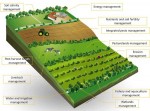
Agriculture, Sustainable
High-Level Conceptualizations: Some Foundation Principles Since the 1960s the concept of sustainable agriculture has been increasingly used to denote a variable but significant rupture with what has been termed the more dominant agri industrial model of agriculture and rural development. In general terms it can be defined as referring to the environmental or ecological soundness of the agricultural production processes or […]
Oceans of Conflict and Imagination
Overriding these turns to the ocean across the various subdisciplines of human geography are two increasingly prevalent geographies of the ocean: the construction of the ocean as a site of conflict and its construction as a space of imagination. The rise of the ocean as a site of conflict is a direct result of its dominant management paradigm, wherein specific zones […]
Economic Geographies of the Sea
Finally, economic geographers as well are beginning to direct their attention to the ocean. Countless local and national economies are driven by the tourism sector and, within the tourism sector, a wide range of activities involve tourists embracing the ocean, whether from the shore, a ship, the surface, or beneath the waves. Economic gain is also constructed in the ocean […]
Environmental Geographies of the Sea
Just as historically there has been little cultural geography of the sea, similarly few human geographers until recently have focused on the ocean as a space of nature. To some extent, this likely is because, until recently, it was believed that humans could do little to influence the condition of the marine environment or the status of marine resources. Prior […]
Cultural Geographies of the Sea
While contemporary studies of the political geography of the sea can draw upon a long history of political geographers studying maritime conflict, the study of marine issues is quite new in cultural geography. Of course, there always have been marine cultural geographies; seafaring and fishing communities invariably display distinct cultural formations that reflect and impact the surroundingmarine environment. Historically, […]
Political Geographies of the Sea
Historically, when human geographers have studied the ocean, they most often have looked to the sea as a space of politics and, in particular, as an arena for geopolitical conflict. The ocean has been viewed as a space in which the forces of land based states meet as each attempts to control crucial areas of the sea (e.g., choke points […]
Emergent Geographies of the Sea
These epistemological shifts, in turn, have led to new areas of research in the human geography of the ocean. In the remainder of this section, four areas of human geography are reviewed: political, cultural, environmental, and economic geographies of the sea.
A Sea Change in Epistemology
In recent decades, each of these barriers to human geographic research on the ocean has been challenged by broad reaching shifts in social thought. Turning first to the barrier of state centrism, since the 1970s the rise of globalization studies has led to the emergence of a number of perspectives that challenge the prevailing view of the world as a […]

Oceans
The Forgotten 71% Oceans cover 71% of the Earth's surface and contain 97% of the planet's water. Over 20% of the world's petroleum is derived from offshore sources and 95% of world trade by weight, or two thirds by value, is carried by ship. Eighty percent of the world's fish catch comes from the ocean, supporting the livelihoods of 140 […]
The Future of Agricultural Land Preservation
Government responses to the urbanization of agricultural land have recognized the need to develop programs to support agricultural viability in conjunction with agricultural land preservation policies. However, policies to protect agricultural land must account for the uncertainty of the agricultural economy. If farming becomes too unprofitable an occupation, it will not be economically viable for governments or private landowners to […]
Approaches for Preserving Agricultural Land
Since the realization was made that the conversion of agricultural lands to urban uses in the post World War II era was having an impact on the ability of farmers to operate, and threatening future food security in the Western world, a range of approaches have been implemented. Some were designed specifically for, or dominated by, agricultural interests. Others […]
Agricultural Land Preservation
Why Protect Agricultural Land The success of today's agricultural sector is vital to the economy of most nations. In Canada, for example, agriculture is the third largest contributor to the gross domestic product and employs over 762 000 people, but its supply of agricultural land is limited and unevenly distributed, with only 11% of the land base […]
The Second Half of the Twentieth Century
From the 1950s, agricultural policy was a main driving force within the growing European Economic Community (EEC). Already during the 1950s, agriculture in France and the Netherlands had recovered from wartime damage and searched for new export markets. Germany, that had lost many of its most productive agricultural regions, aimed at reestablishment of its position as an industrial nation and expected […]
The Nineteenth and Early Twentieth Centuries
The Agrarian crisis of the 1880s brought yet another transformation. Again, this was mainly a grain crisis, caused by the competition of Russian and, particularly, American grain. The transport revolution – intercontinental trains and ever larger transatlantic steamships – tipped the balance and within a few years American grain, cheaply produced on large farms, flooded the European market. European countries reacted […]

The Early Modern Period
A slow recovery started during the fifteenth century and continued during the 'long sixteenth century'. A new phase of economic integration started during this period, in which the European economies and landscapes re grouped around northwestern Europe, the only re maining core region. The main center of trade moved within the core region from Antwerp (sixteenth century) to Holland (particularly Amsterdam, seventeenth […]
The Late Middle Ages
During the first half of the fourteenth century, the population had reached a maximum. A population that had become increasingly dependent on grain, was hit hard by a succession of bad harvests and, in the years after 1346, by the large plague epidemic. Within a few decades, the European population dropped by almost a third. There were exceptions. In the Low […]
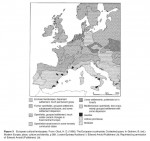
Early and High Medieval Europe
In many parts of Europe, within as well as outside the struggling Roman Empire, the third to fifth centuries AD were a period of crisis and de population. This was followed by a slow recovery in the following centuries. During the seventh to ninth centuries, the peripheries of Europe, Scandinavia, Ireland, Muslim Spain, and the Byzantine Empire, showed the more […]

Agrarian Transformations
For thousands of years, landscape and society have been heavily influenced by developments in agriculture. In most preindustrial societies, agriculture occupied the majority of the population. Holland was an early exception, with the majority of the population already living in towns at the end of the sixteenth century. Most countries in Western Europe reached this point somewhere during the first […]
Gendered Boundaries
In considering what it is about the gender(ing), situation(s) and treatment of women that entails their heightened susceptibility to agoraphobia, geographers have considered the potential significance of gender role stereotypes. For women, such stereotypes involve characteristics not dissimilar to those found in agoraphobia; a woman's place is commonly described as in the home. Such notions about proper behavior and roles […]
Managing Social Space
Common Coping Mechanisms Given the crisis state of spatial affairs entailed by agoraphobia, it is unsurprising that the subjects should attempt to find ways to protect themselves. Erving Goffman's sociology has been inspirational for feminist studies of agoraphobia because of his attempts to elucidate the nature of less pathological social anxieties (such as everyday embarrassments) and the tactics by which they […]
Embodying and Theorizing Agoraphobia
Placing Panic Drawing on in depth interviews with agoraphobics, geographical studies have stressed that the phenomeno logical aspects of agoraphobia of overwhelming signifi cance for its sufferers relate primarily to the experience of panic. A panic attack involves a wide range of terrifying mind–body symptoms, including: chest pain, palpitations, and shortness of breath; feelings of going crazy and losing control […]
Agoraphobia
Introduction Since the late 1970s, there has been a surge of interest in agoraphobia and panic among clinicians, and publications on the subject often begin by drawing attention to its contemporary prevalence. Agoraphobia is described by clinical researchers as one of the most common – as well as distressing – phobic disorders encountered. The significance of phobic anxieties for contemporary […]
How Do Agglomerations Emerge and Develop – Historical Approaches
Spatial agglomerations of similar and related economic activity often have deep historical roots. An alternative way to understand the agglomeration phenomenon is to study real agglomerations historically in order to analyze their birth, growth, saturation, decline, and possible reinvigoration. The origin of the agglomeration in such accounts, that is, the event or action which triggered subsequent developments, sometimes turns out to […]
What Factors Make Up Agglomeration Economies?
Identifying and analyzing those advantages that may accrue to firms located in close juxtaposition to other similar and related firms, rather than being located in isolation, is one way to account for the agglomeration phenomenon. The concept of agglomeration economies (or localization economies) refers to these advantages. The basic understanding of this concept was in place already a century ago. Thus, Alfred […]
False Paradoxes and ‘Circular Logics’
The research problem attached to the agglomeration phenomenon may seem to be trivial. We have a phenomenon that can be observed in reality. Firms in the same or related industries often – although far from always – tend to co locate in space, and this should reasonably indicate that there should be some advantages connected to such a […]
The Core Issue of Economic Geography
In the context of economic geography, agglomeration may refer to a concentration in space of some entity, or the process by which such a spatial formation is created. While the dictionary definitions signal that agglomeration is to be understood as an unsystematic, haphazard process, where some entities pile up together in space but are not really affected in any particular […]
Agglomeration
The term agglomeration can be used both as a noun and as a verb. Dictionary entries of agglomeration as a noun will typically refer to a ''collection or mass of things rudely or loosely thrown or huddled together,'' an ''unmethodical assemblage,'' a ''confused or jumbled mass,'' or merely a ''clustering or cluster.'' As a verb, consequently, agglomeration refers to […]
Conclusion: Performing age
Recent work within geography has highlighted the performed nature of identity. This approach has been very useful in deepening understandings of the ways gender and sexuality, for example, are not fixed or given but continually performed and endlessly capable of disruption and reinvention. There has been very little work approaching age in this way, although such an approach offers many […]
Relational Geographies of Age
This section considers current trends and directions being addressed by and impacting upon geographies of age. Relational approaches to age help render the operation of age explicit within all geographical analysis and support greater awareness of age and ageism throughout human geographical research. This has strong parallels with the way understandings of gender and race now inform a vast range of […]

Geographies of Older People
While there has been significantly less geographical work on older than younger people, there is a growing willingness among geographers to explore the ways space, place, and scale impact upon and are shaped by older people. Geographers have thus looked at ageism within spatial planning and the ways older people experience the built environment as well as how older age […]
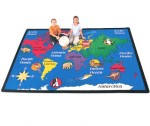
Children’s Geographies
There has been sufficient research, publication, and teaching activity in the field of children's geographies since Alison James' seminal piece in the journal Area in 1990 that a distinct subdiscipline has emerged, complete with its own journal (Children's Geographies, founded in 2003) and a specialty research group of the RGS IBG (Children, Youth and Family Working Group, formed in 2006). As the […]
Ageism and Age
Age is important. Alongside gender, race, ethnicity, sexual orientation, class, dis/ability, and other axes of social difference, age shapes the social world at every scale and in many different ways. In common with all lines of social difference, age is also the site of oppression and prejudice. Ageism, or prejudice based on age, takes many forms. It is one […]
Mobility and Older People’s Quality of Life
Studies of migration tend to feature the more visible and radical forms, like retirement to Spain or Costa Rica, or the return from London or New York to Jamaica, when most migrations by older people are local housing adjustments – like those by adults of all ages. Many local moves make an important contribution to maintaining older people's independence and […]
Recent Developments in Retirement Migration
The percentage of United States retirees who migrate abroad is very small, but given the very large population and the recent surge of international travel and communications, the absolute number is growing. The phenomenon has recently attracted a major study by the Migration Policy Institute in 2006 in Washington DC. This found that ''the US born senior population (aged […]
Migrants in Advanced Old Age
A particular concern of both older people's welfare organizations and the public authorities in areas with high concentrations of older migrants is that some, through poor planning, bad luck, or sickness, end up in situations in which they are isolated, impoverished, and out of touch with both formal and informal support. Most who move long distances for retirement, whether within […]
Older Minority-Group Migrants in Rich Countries
In most developed countries, many surveys of the health and treatment needs of minority group older migrants are now undertaken by health and social services agencies, which of course have privileged access to their patients, and have the resources needed to translate questionnaires and employ bilingual interviewers. The findings of such surveys are largely descriptive and policy and practice oriented, and have […]
Return and Family-Joining Older Migrants
Alongside the two main types of older migrants, there are others about which much less is known. The most apparent are 'return migrants', the labor migrants of long residence who return to their native regions and countries when they cease work. They are themselves diverse, and their migrations straddle internal and international moves. In all countries, some who moved […]
Aged Labor Migrants
A contrasting group of older migrants comprises labor migrants who have reached old age in the countries to which they moved in their early adult years. They are also socially diverse, but in Europe very many migrated from the Caribbean, north and west Africa, Turkey, the Middle East, and the Indian subcontinent to the cities of northwest Europe from the 1950s […]
International Retirement Migration
The first international retirement flow to attract the attention of American researchers was of Canadians to Florida, and the first to attract the attention of European population geographers was the settlement of northern European retirees in various regions of southern Europe. The latter moves began to increase rapidly during the 1960s for a host of reasons: the new democratic regimes in […]
Internal Retirement Migration
A third interest shared by population geographers and social gerontologists has been to understand the motivations, patterns, and consequences of retirement migration. Until the 1980s, almost all such moves were within various European countries, the United States, and Australia. The settlement of estranged aristocrats and retired senior soldiers and sailors to coastal resorts and spas was evident even before the […]
Migration and Old Age
Although migration researchers focus on young adults' moves, for more than 25 years, population geographers and social gerontologists have studied old age migrations and migrants. The first interest, in the 1940s, was whether moves into nursing homes or between hospitals entailed a mortality risk. By the early 1980s, Pastalan, in Rowles and Otha in 1983, was able to review 34 US […]

Ageing and Mobility
Migration can be defined as a change in residence from one location to another. Such movements are immensely diverse, from short distance house changes to intercontinental moves. Many moves are short term, have little impact on the migrants' lives, and are reversible; others are permanent and life changing. As migration is a spatial process, it has been keenly studied by […]
Emerging Critical Perspectives
Reflecting the emergence of critical perspectives in both social gerontology and human geography, research published since the mid 1990s draws much more on social theory, focuses on constructions and representations of aging and challenges accepted social norms about aging. Moving away from treating older people as 'objects' of study, several studies engage with aging and the concept of embodiment, and talk […]

Residence and Care
It is typical for studies in this field to simultaneously capture elements of older peoples' residential (living) arrangements, and their health and social care. This is because in older age, many older people require both assistance with their everyday living activities and various health and social services. Consequently many places – including nursing homes, residential homes, assisted living arrangements, retirement communities, and […]

Negotiating Environments
Some of the earliest geographical research, which engaged with older peoples' changing relationships with environments, drew heavily on environmental psychology published in the 1960s and 1970s, and in particular on the pathbreaking work of gerontologist Powel Lawton. Lawton's ecological theory of aging was most famously articulated through his environmental docility hypothesis (also associated with terms such as aging and […]

The Health of Older Populations
Another long standing strand of research is focused on the health of older populations. Population geographers and demographers, along with epidemiologists and health geographers have played central roles. At the national scale, life expectancy in specific countries is an important consideration and bodies such as the World Health Organization have produced a number of publications outlining rates and variations in expectancy. Health […]

Movements of Older Population
Over the last 20 years, a great deal of research has focused on movements of older population. At one level, research has focused on broad migration patterns. Other studies – often which are qualitative have investigated some important social contexts and consequences such as family networks and the pushes and pulls to and from different locations in migration decision making, […]

Population Aging
Since the 1950s, a long standing strand of aging and health research has been concerned with population aging. It is an area of interest dominated by the work of demographers and population geographers who have particular expertise in handling and analysing large population data sets that are essential sources for these studies. Researchers have identified the spatial patterning and characteristics of demographic […]
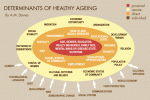
Ageing and Health
When considering the potential importance of the geographical study of older people and populations, some basic facts are well worth remembering. Older people – typically defined by governments and other officialdom as being over 65 years of age – constitute a significant and growing proportion of the general populations of both developed and developing world counties; the former approximately 15%, the […]
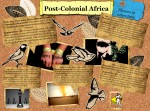
Postcolonial Africa
The phrase, 'postcolonial Africa' is literally a reference to the continent in the period after the end of European colonialism. However, the usage of the phrase in this sense is actually inadequate, because the autonomy of African states is so circumscribed and the legacies of colonialism so great as to lead many to question how far African countries can be considered […]

(Under)Developing Africa
1In the nineteenth-century, European geographers explored the African continent and then aided and abetted the colonial conquest. In the twentieth century, they mostly served the cause of establishing and maintaining colonial rule during the first half, and then worked in the cause that came to be called Africa's 'development', in combination with new generations of African professional geographers. This project of […]